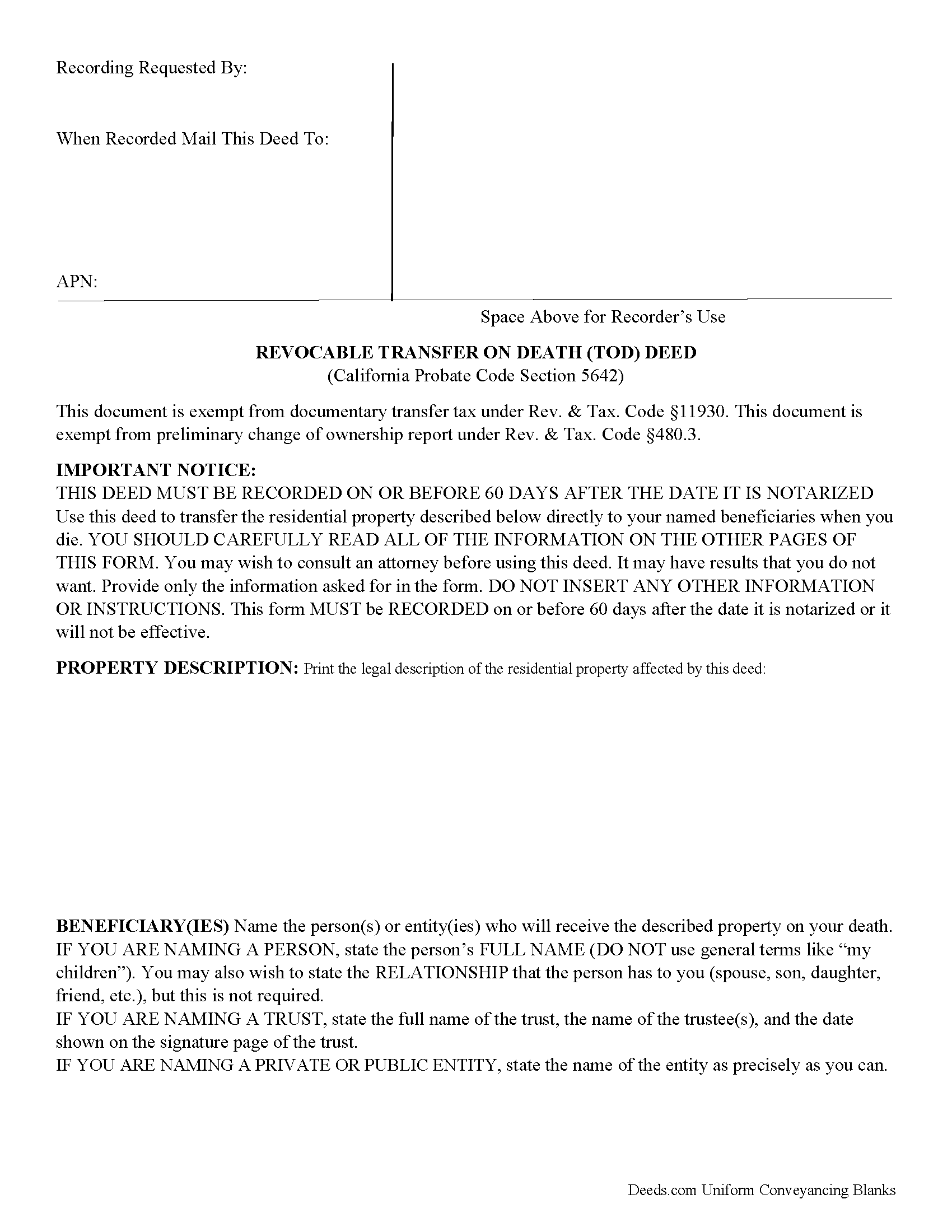Download California Transfer on Death Deed Legal Forms

California Transfer on Death Deed Overview

Use this form to transfer real estate at death, but outside of a will and without the need for probate distribution. Execute the TODD form, then record it during the course of your life, and within 60 days of the signing date (5626(a)). Note that unlike grant deeds or quitclaim deeds, there is no change in ownership when transfer on death deeds are recorded (5650), so they are exempt from transfer taxes and the Preliminary Change of Ownership Report (PCOR).
Section 5650 explains that while you are alive, you retain absolute ownership of and control over your property. You may sell, mortgage, rent, or otherwise use the real estate in any lawful manner, without input from or notice to the beneficiaries, or even modify or revoke the future transfer.
Be aware, too, that the TODD is NOT affected by provisions in your will (5642(b)). Best practices dictate that any change to an estate plan initiates a review of the whole thing, so to reduce the chance for conflict, ensure that the transfer on death deed reinforces the will and other related documents.
Beneficiaries take title to the property under the rules set out at section 5652. Any associated debts, obligations, or agreements in place when you die follow the real estate to the beneficiaries. In addition, the title transfers without warranty, so the beneficiaries might find themselves liable for future claims against the property. For these reasons, among others, some beneficiaries might wish to disclaim the gift (5652(a)(1)).
As it stands, California's transfer on death deed is not valid for real estate held in joint tenancy or as community property with right of survivorship (5664).
5624. A revocable transfer on death deed is not effective unless all of the following conditions are satisfied:
(a) The deed is signed by the transferor and dated.
(b) The deed is signed by two witnesses who were present at the same time and who witnessed either the signing of the deed or the transferor's acknowledgment that the transferor had signed the deed.
(c) The deed is acknowledged before a notary public.
SEC. 10. Section 5625 is added to the Probate Code, to read:
5625. (a) Any person generally competent to be a witness may act as a witness to a revocable transfer on death deed.
(b) A revocable transfer on death deed is not invalid because it is signed by an interested witness.
(c) If a beneficiary of a revocable transfer on death deed is also a subscribing witness, there is a presumption that the witness procured the revocable transfer on death deed by duress, menace, fraud, or undue influence. This presumption is a presumption affecting the burden of proof. This presumption does not apply where the witness is named as beneficiary solely in a fiduciary capacity.
Overall, the Simple Revocable Transfer on Death Deed offers a convenient, flexible option to consider as part of an overall estate plan. Even so, they may not be appropriate in all cases. Contact an attorney for complex situations or with any questions.
Included NOTICE OF REVOCABLE TRANSFER ON DEATH DEED Form
5681. (a) After the death of the transferor, the beneficiary of a revocable transfer on death deed shall serve notice on the transferor's heirs, along with a copy of the revocable transfer on death deed and a copy of the transferor's death certificate. (b) The notice required by subdivision (a) shall be in substantially the following form:
(California Transfer on Death Deed Package includes form, guidelines, and completed example)